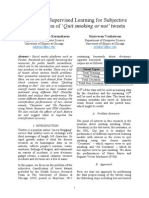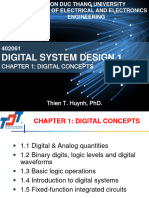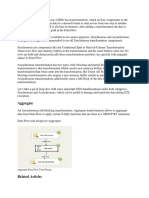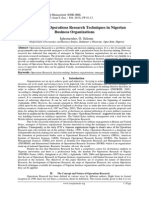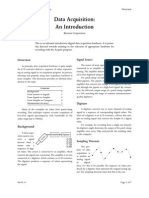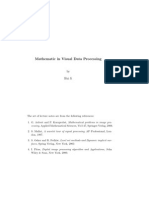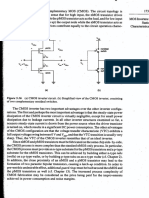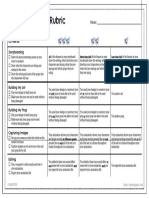Digital Image Processing and Analysis With CVIPtools PDF
Uploaded by
Amr YassinDigital Image Processing and Analysis With CVIPtools PDF
Uploaded by
Amr YassinBook Review
Digital Image Processing and Analysis: Human and Computer
Vision Applications with CVIPtools, Second Edition
Scott E. Umbaugh, 977 pp., ISBN 978-1-4398-0205-2, CRC using the package both while studying the material and working
Press (2011), $119.95 hardcover. the exercises at the end of each chapter.
A typical chapter in the book begins with an introduction
Reviewed by Jeffrey Snyder and Elena Fedorovskaya, Kodak and an overview of a selected topic, such as image restora-
Research Laboratories, Rochester, New York tion and reconstruction. To facilitate the overall understanding
Digital image processing and analy- of a topic, the author then presents a system model, which in-
sis is an immense field with applica- cludes a block diagram and description of the component blocks.
tions in robotics, space exploration, Next, algorithms satisfying the requirements for each component
medicine, entertainment, photogra- are introduced. At this point, images are used to illustrate the
phy, defense, and other areas, and behavior and tradeoffs for each algorithm. The author provides
is growing larger every year. This usage instructions for CVIPtools, enabling the reader to experi-
leads to an increased demand for ment and enhance their understanding. Following the main ex-
publications presenting the founda- position, each chapter contains a key points section that sum-
tions of digital image processing to marizes the concepts defined in the chapter. A set of pen and
a broad audience in a systematic paper problems are followed by programming exercises. A list
and practical way. Meeting such a of references and suggestions for further reading completes the
demand in the second edition of his chapter.
easy-to-read book, Scott Umbaugh The book is organized into five sections. The first section,
provides an introduction to this field comprising chapters one and two, is titled “Introduction to Dig-
for students, researchers, and engi- ital Image Processing and Analysis.” Chapter one is a concise
neers. The book covers a wide breadth of topics, starting with a description of the digital image-processing field that the author
high-level description of the author’s view of the field, and ending divides into computer-vision applications and human-vision appli-
with a detailed description of programming tools and a practical cations. Historically, digital image processing grew from electrical
guide for the development of various applications. Although the engineering as an extension of the signal-processing branch, and
book has nearly 1000 pages, it would be impossible to cover each the computer science discipline was largely responsible for devel-
of these topics in depth. Instead, the author focuses on providing opments in computer vision. Umbaugh refers to digital image pro-
the reader with a basic understanding of each topic area, illustra- cessing, or computer imaging, as the general field, with separate
tions of what can be done with the various algorithms presented, computer- and human-vision application areas. Computer-vision
and a means to experiment with their new-found knowledge. applications process an image for later use by a computer, while
A unique feature of the book is the inclusion of the software human-vision applications are motivated by a desire to improve
CVIPtools, provided on an attached CD-ROM. CVIPtools has image quality for a user or to reduce the storage burden on the
two major pieces. The first is the CVIPtools application, which user by involving a human being in the visual loop. Both types
has a graphical user interface and allows the user to read an of applications employ image analysis, defined to include im-
image, select algorithms from a menu, change the parameters age segmentation, feature extraction, pattern classification, and
of algorithms, and apply the algorithms to the image. The sec- transforms. Human-vision applications include image restoration,
ond component is CVIPlab, which consists of the source code enhancement, and compression.
for the image-processing algorithms in CVIPtools and a simple Chapter two contains an overview of imaging systems. It starts
console application. With the help of Microsoft Visual Studio or by outlining the basic model for visible light imaging, including
some other development environment, the user can modify the the geometry of the lens, object plane, and imaging plane, then
source code of CVIPlab and create new applications and algo- proceeds with the introduction of CVIPtools, and finishes with the
rithms. The CVIPtools package is used to demonstrate concepts discussion of image representation in the form of digital files of
and analysis algorithms introduced throughout the book, and to various types and formats. The exercises of the section focus on
enable the reader to experiment with existing image-processing the basic principles of imaging systems.
algorithms and develop new algorithms, then use their applica- Section 2, “Digital Image Analysis and Computer Vision,” in-
tions to explore practical problems. cludes chapters three through six. Chapter three is an introduc-
The text, which is richly illustrated with both drawings and ex- tion to digital image analysis. Image analysis is presented as a
ample images, and the CVIPtools package are highly integrated. sequence of steps that consists of preprocessing, data reduc-
This creates a learning environment that is particularly suited tion, and feature analysis. Each of the steps is further broken
to students, computer scientists, and application developers. A down in several block diagrams. Convolutions, translation and
significant portion (at least 30%) of the book is devoted to the rotation, arithmetic and logical operations, and spatial filters are
detailed description of the CVIPtools package. The intent is for introduced as ways to process a region of interest in the im-
the reader to expand their learning experience by installing and age. Quantization and thresholding are discussed as methods
Journal of Electronic Imaging 039901-1 Jul–Sep 2011/Vol. 20(3)
Downloaded From: https://www.spiedigitallibrary.org/journals/Journal-of-Electronic-Imaging on 13 Feb 2020
Terms of Use: https://www.spiedigitallibrary.org/terms-of-use
of image data reduction and basic image analysis that can be and discusses three types of image-processing applications that
performed on pixel values or their spatial coordinates. K-means are used to produce images for human viewing. Chapter seven
clustering is presented as an algorithm to find a threshold in an provides a short overview of the basic functions of human visual
image with good object-to-background contrast. Connectivity and perception, understanding of which is required for the develop-
labeling are mentioned in the context of more than one object la- ment of the relevant image-processing applications. The anatom-
beling. The chapter ends with an example, using CVIPtools to ical and physiological structure and light sensitivity of the human
show how a simple decision tree-based object classification tool eye are mentioned. The phenomena related to spatial frequency
can be created. sensitivity, temporal resolution of the HVS, as well as brightness
Chapter four presents segmentation and edge detection as adaptation, simultaneous contrast, and color metamerism are
techniques to take vast amounts of low-level pixel values and briefly described. A relationship between these phenomena and
extract useful data that represent higher level information. The corresponding digital image properties is pointed out. Addition-
standard gradient edge-detection operators, those based on the ally, a section on image quality gives examples of subjective as
first and second derivative of the luminance channel, are de- well as objective image quality measures, utilized when the ef-
fined and demonstrated. The discussion of these operators is fects of image enhancement, restoration, or compression need
very clear and the results are amply illustrated with many high- to be evaluated.
quality images. The book truly excels in showing the reader Image enhancement is the topic of chapter eight. The au-
the effects of various operations on the image. The author dis- thor groups enhancement techniques into the categories of point,
cusses more complex edge-detection algorithms, such as the mask (i.e., region), or global operations, depending on which pix-
Canny algorithm. He also includes a nice section on the per- els influence the pixel being modified. These same algorithms
formance evaluation of edge-detection techniques. Once you can also be classified as either spatial or frequency/sequence
have found the edges in your image, what are you going domain operations. The majority of the chapter is devoted to
to do with them? You could use the venerable Hough trans- histogram-based techniques and various types of filtering, in-
form to detect lines or the Harris corner detection algorithm to cluding sharpening and smoothing. Both linear and nonlinear
find corners. Each of these is described and evaluated in the approaches, including adaptive techniques, are discussed. CVIP-
text. This leads to a discussion of image-segmentation meth- tools is used to generate many illustrations for the various
ods, where the three different categories of segmentation al- algorithms.
gorithms are explored: region growing and shrinking; cluster- Image-restoration methods are greatly benefitted by having
ing; and boundary detection, the latter being an extension of an accurate model of the process used to create the image. In
the edge-detection techniques. The chapter ends with a discus- chapter nine, the author presents a standard system model for
sion of morphological filtering as filtering of objects in the spa- this process and then explores what can be done to improve
tial domain, wherein binary, monochrome, and color images are the image under various additional assumptions. In the author’s
considered. model, the image is subject to a point-spread function degra-
Chapter five offers a foray into discrete transforms aiming dation of some sort (e.g., motion blur), and then degraded by
to provide information about the image spatial, frequency, and additional noise. The author discusses assumptions and various
sequency domains. The Fourier transform is defined and illus- techniques to mitigate the noise. Restoration techniques involv-
trated. The properties of the Fourier transform, which makes it so ing both linear spatially invariant filters and adaptive filters are
useful in linear space-invariant systems, are formulated but not presented.
derived. Sampling and aliasing are briefly mentioned. In addition Image compression involves data reduction, mapping, quan-
to the Fourier transform, the discrete cosine, Walsh-Hadamard, tization, and coding processes. In chapter 10, the author de-
and wavelet transforms are reviewed. The author emphasizes scribes each of these. Lossy and lossless coding techniques are
the multiresolution decomposition aspect of wavelet transforms, discussed. The reader is exposed to ideas from both the spatial
such as the Haar transform, that allow them to retain both and transform domains. Near the end of the chapter, the au-
spatial and frequency information. The principal components thor provides a brief introduction to the JPEG and JPEG2000
transform (PCT) is also described. PCT use in decorrelating the standards.
components of a complex signal, such as a multiband image, and Section 4, encompassing chapters 11 through 13, is devoted
its relationship to compression, are discussed. The usefulness to programming and application development using CVIPtools.
of filtering for selectively modifying and analyzing various com- The source code and Visual Studio project for the console-based
ponents of the spectral information is exemplified by considering application CVIPlab are provided on the CD. Chapter 11 dis-
the effects of lowpass, highpass, bandpass, and bandreject cusses how to compile the software and extend it so that an
filters. The difference between ideal versus nonideal filters is interested party could add their own features. The data struc-
explained. tures used in CVIPtools are also defined. Chapter 12 describes
Feature analysis and pattern classification, often considered algorithm development using CVIP-ATAT, a tool used to analyze
as the final stages in the image-analysis process, are the topics the performance of a sequence of algorithms on a population of
of chapter six. The author discusses the steps involved in feature images, and CVIP-FEPC, a tool used to develop pattern classi-
extraction, analysis, and pattern classification, introducing fication algorithms. Several real-world examples are included to
shape, histogram, color, spectral, and texture-related features illustrate the usage of these tools. Chapter 13 is a programmer’s
and their description and similarity measures. The utility of guide to the C functions available in CVIPtools.
CVIPtools is once again asserted by presenting examples of The final section of the book, Sec. 5, contains a set of ap-
the processes involved in feature extraction and pattern classi- pendices, which provide brief instructions for the installation and
fication. Still, the widely popular SIFT, GIST, and SURF features usage of the CVIPtools software.
are not mentioned. While some common pattern-classification Altogether, the author has produced a book that presents both
techniques, such as linear discriminant analysis and neural nets the practical and theoretical aspects of digital image processing
are discussed, descriptions of other common approaches, such in a way that is efficient for learning, as well as research- and
as decision trees and support vector machines, are missing. application-oriented development. He does an excellent job of
Chapters seven through ten are included in Section 3, “Dig- showing how algorithms work and what the results look like. The
ital Image Processing and Human Vision.” In this section, the drawback for the more sophisticated reader lies in the fact that
author describes elements of the human visual system (HVS) he does not spend a lot of time on theory and some topics are
Journal of Electronic Imaging 039901-2 Jul–Sep 2011/Vol. 20(3)
Downloaded From: https://www.spiedigitallibrary.org/journals/Journal-of-Electronic-Imaging on 13 Feb 2020
Terms of Use: https://www.spiedigitallibrary.org/terms-of-use
not covered in depth. For example, during the discussion of bi- ries of academic projects to be as polished as a commercially
nary morphology in chapter four, the author does not present the developed tool. Even with these minor problems, the CVIPtools
set notation for binary morphology and does not spend much package provides an outstanding value to the reader who is mo-
time talking about gray-level morphology. This is understand- tivated to explore.
able, however, as he is attempting to cover “all areas of digi- Overall, this is an excellent text for the student or professional
tal image processing and analysis, both human and computer looking for a practical introduction to or an overview of the wide
vision applications” in one volume. Many of the chapter topics, world of digital image processing and analysis.
such as transforms and pattern-classification analysis methods,
have been expanded in books by other authors. While the author Jeffrey Snyder is a member of the com-
presents a very good introduction to the main areas of digital im- putational science group at the Kodak Re-
age processing, the reader will want to look elsewhere for more search Labs in Rochester, New York. He
detailed theoretical discussions about specific topics. received his MS in computer science from
The CVIPtools application and libraries are very useful. Com- the University of Rochester and has been
pared with the first edition, two newly added software tools, the with Kodak since 1979. His work has in-
Computer Vision and Image Processing Algorithm Test and Anal- cluded algorithm development and soft-
ysis Tool (CVIP-ATAT) and the CVIP Feature Extraction and Pat- ware engineering for some of Kodak’s suc-
tern Classification Tool (CVIP-FEPC) offer a more complete set cessful imaging applications, such as Ko-
of tools for developing and testing algorithms. However, a few dak Perfect Touch. His current interests
minor problems can be mentioned. First, the user interface of are in computer vision, image processing, and computer-assisted
the CVIPtools application is somewhat unconventional and dif- storytelling. He is a member of the IEEE Computer Society and
ferent than that in PhotoShop, IrfanView, and GIMP, three other the ACM.
well-known packages that have overlapping functionality. One
distinction is that, unlike the other applications, CVIPtools uses a Elena Fedorovskaya has been a re-
prefix approach to operate on the image. This requires the user search scientist at Kodak Research Labs
to select an operation first and then select the data. A second in Rochester, New York, since 1997. She
problem involves a bug in the CVIPtools application. False edges received a PhD in psychophysiology and a
sometimes appear when the user attempts to display an image MSc degree in applied mathematics, both
with a higher resolution than the display. A final minor critique can from Lomonosov Moscow State Univer-
be attributed to the design of the CVIPtools C function libraries. sity, Russia. Her work at Kodak focuses
Although the author provides a very useful set of functions, they on human-centered computing involving
all allocate the result image inside the function. Some software modeling perceptual, cognitive, and emo-
developers may prefer to have more control over memory alloca- tional aspects of human experience in re-
tions by externally allocating memory to the function. One would lation to images and imaging systems. She is a member of IS&T
not expect an image-processing application developed as a se- and SIGCHI.
Journal of Electronic Imaging 039901-3 Jul–Sep 2011/Vol. 20(3)
Downloaded From: https://www.spiedigitallibrary.org/journals/Journal-of-Electronic-Imaging on 13 Feb 2020
Terms of Use: https://www.spiedigitallibrary.org/terms-of-use
You might also like
- MRI Made Easy 2nd Ed - Govind B. Chavhan - Jaypee79% (29)MRI Made Easy 2nd Ed - Govind B. Chavhan - Jaypee229 pages
- Operations Research With Case Study On GM and Ford100% (1)Operations Research With Case Study On GM and Ford15 pages
- A Practical Method For Calculation of Over-Excited Region in The Synchronous Generator Capability CurvesNo ratings yetA Practical Method For Calculation of Over-Excited Region in The Synchronous Generator Capability Curves6 pages
- Digital System Design 1 - Chapter 1 SlideNo ratings yetDigital System Design 1 - Chapter 1 Slide44 pages
- Power Plant Equipment Lecture-4 (Numerical)No ratings yetPower Plant Equipment Lecture-4 (Numerical)13 pages
- Resolving Security and Data Concerns in Cloud Computing by Utilizing A Decentralized Cloud Computing OptionNo ratings yetResolving Security and Data Concerns in Cloud Computing by Utilizing A Decentralized Cloud Computing Option6 pages
- Applications of Regression Analysis by Using R Programming - Tara Qasm Bakr0% (1)Applications of Regression Analysis by Using R Programming - Tara Qasm Bakr29 pages
- Modern Retail Analytics: Data Visualization Using TableauNo ratings yetModern Retail Analytics: Data Visualization Using Tableau5 pages
- Small-Signal Discrete-Time Modeling of Digitally Controlled PWM Converters PDFNo ratings yetSmall-Signal Discrete-Time Modeling of Digitally Controlled PWM Converters PDF5 pages
- (Ebook PDF) Data Mining For Business Analytics: Concepts, Techniques, and Applications With JMP Pro Download PDF100% (3)(Ebook PDF) Data Mining For Business Analytics: Concepts, Techniques, and Applications With JMP Pro Download PDF41 pages
- Web Logic Installation and Configuration GuideNo ratings yetWeb Logic Installation and Configuration Guide22 pages
- Comparison of Different Simulation Tools For Load Flow Analysis in Power Systems100% (1)Comparison of Different Simulation Tools For Load Flow Analysis in Power Systems6 pages
- Introduction To Programming Using Java - TextbookNo ratings yetIntroduction To Programming Using Java - Textbook790 pages
- Falling in LoveWith Other Essays On More Exact Branches of Science by Allen, Grant, 1848-1899No ratings yetFalling in LoveWith Other Essays On More Exact Branches of Science by Allen, Grant, 1848-1899142 pages
- Study Material On Computer Organization and ArchitectureNo ratings yetStudy Material On Computer Organization and Architecture80 pages
- Dynamic Model Analysis of Three Phase Induction Motor Using Matlab SimulinkNo ratings yetDynamic Model Analysis of Three Phase Induction Motor Using Matlab Simulink6 pages
- SAS Enterprise Guide 4.1 A Basic Guide For Banner Finance UsersNo ratings yetSAS Enterprise Guide 4.1 A Basic Guide For Banner Finance Users83 pages
- Data Acquisition: An Introduction: Bruxton Corporation100% (1)Data Acquisition: An Introduction: Bruxton Corporation7 pages
- Role of Power Electronics in Smart Grid InfrastructureNo ratings yetRole of Power Electronics in Smart Grid Infrastructure20 pages
- Simulink Time 1 Simple Oscillator: M y + C y + Ky 0No ratings yetSimulink Time 1 Simple Oscillator: M y + C y + Ky 016 pages
- Image Processing and Computer Vision: GoalsNo ratings yetImage Processing and Computer Vision: Goals14 pages
- PCA A Simple Principal Component Analysis ExampleNo ratings yetPCA A Simple Principal Component Analysis Example9 pages
- Instant download Nikon Corey Hilz pdf all chapter100% (2)Instant download Nikon Corey Hilz pdf all chapter81 pages
- Casio - Digital Camera QV-300 B - Service ManualNo ratings yetCasio - Digital Camera QV-300 B - Service Manual28 pages
- Catalogo de Productos Seguridad JUnio 2024No ratings yetCatalogo de Productos Seguridad JUnio 2024121 pages
- Research Article: Depth Analysis of Greyscale Integral Images Using Continuous Multiview Wavelet TransformNo ratings yetResearch Article: Depth Analysis of Greyscale Integral Images Using Continuous Multiview Wavelet Transform9 pages
- Instant Download Digital Image Processing Practical Approach Borko Furht PDF All Chapters100% (4)Instant Download Digital Image Processing Practical Approach Borko Furht PDF All Chapters65 pages
- Edge Detection Techniques in Processing Digital Images: Investigation of Canny Algorithm and Gabor MethodNo ratings yetEdge Detection Techniques in Processing Digital Images: Investigation of Canny Algorithm and Gabor Method6 pages
- Cooperat Electronic Tech Co.,Limited: Generic ModelsNo ratings yetCooperat Electronic Tech Co.,Limited: Generic Models29 pages






